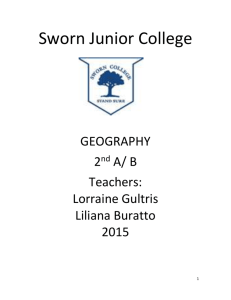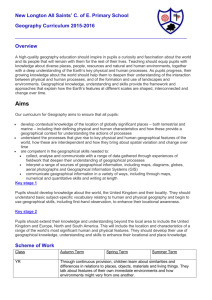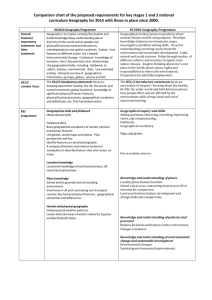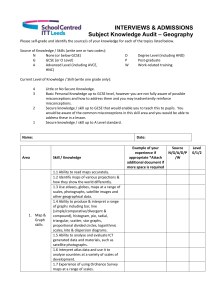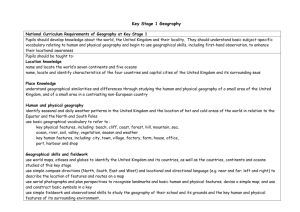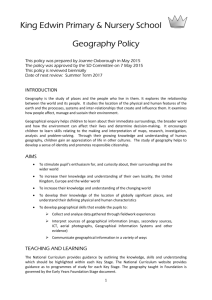pre-ib geography: introduction philosophy
advertisement
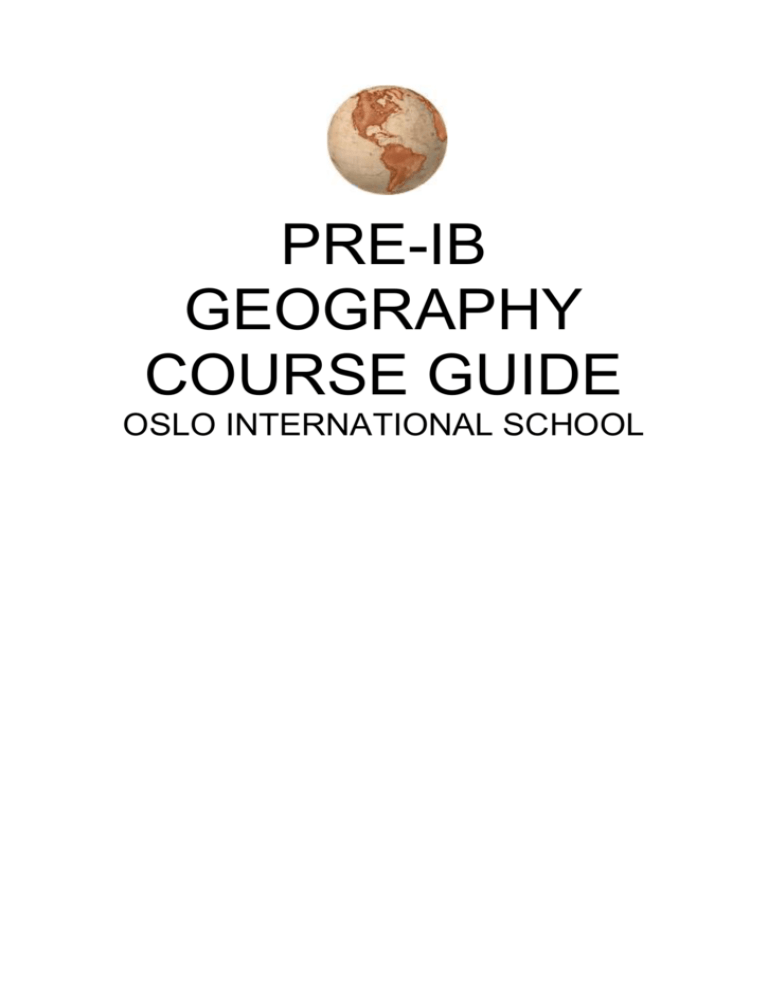
PRE-IB GEOGRAPHY COURSE GUIDE OSLO INTERNATIONAL SCHOOL PRE-IB GEOGRAPHY: INTRODUCTION PHILOSOPHY Geography is concerned with place. Understanding the nature and causes of areal differentiation on the global surface has been the geographer’s task since people first noticed differences between places. Through geography we seek to understand these differences in patterns of human distribution, interrelationships between human society and the physical environment, people’s use of the Earth in time and space, and how these differences are related to people’s cultures and economies. These, and other related themes, express major concerns of our time and reflect the consequences of spatial decisions. In geography’s pursuit of this understanding the questions “where?”, “why?” and “how?” are central. The first of these introduces the issues of location and spatial choice; the latter two signify that modern geography is not content merely to describe but seeks to explain. Beyond these questions, geographers also ask “what if?” as a means of seeking alternatives and giving the subject an applied dimension that can assist decision makers in planning and developing at a variety of geographical scales. COURSE CONTENT The Pre-IB geography course covers the following topics: 1. Employment Structures 2. Farming 3. Resources (energy) 4. Industry 5. Tourism 6. World development and interdependence 7. Britain’s weather and climate 8. World climate 9. Mapwork 10. Fieldwork (to be decided by the class) TEACHING METHODS During the study of each of the syllabus units, a variety of teaching and learning methods will be used like lecturing, discussions, group work, role plays, textbook and computer/Internet exercises, using visual aids like videos, dvds and power point presentations, and fieldwork. The teacher generally introduces, presents and analyses the topics while interpretation forms the basis for class discussions and student assignments. STUDENT RESPONSIBILITIES Students are required to: Arrive at lessons with suitable equipment (required textbooks, notebook, folder with hand-outs, and a ruler). For tests they should bring writing equipment, a ruler, a protractor, a pair of compasses and a calculator. Colour pencils are often useful. Keep materials distributed in class organised. Complete given tasks and homework on time. Take active part in class discussions. PRE-IB GEOGRAPHY: AIMS AND OBJECTIVES AIMS The aims are to: 1. encourage the systematic and critical study of: human experience and behaviour; physical, political, economic and social environments; the history and development of social and cultural institutions2. develop an awareness in the student that human attitudes and beliefs are widely diverse and that the study of society requires an appreciation of such diversity 3. develop a global perspective and a sense of world interdependence 4. develop an understanding of the interrelationship between people, place and the environment and an awareness of the contrasting opportunities and constraints presented by different environments 5. develop a concern for the quality of the environment, and an understanding of the need to plan and manage for present and future generations 6. appreciate the relevance of geography in analysing contemporary world issues, and develop and modify values and attitudes in relation to geographical problems and issues 7. recognize the need for social justice, equality and respect for others; appreciate diversity; and combat bias, prejudice and stereotyping 8. develop an appreciation of the range of geographical methodologies and apply appropriate techniques of inquiry. 9. enable the student to collect, describe, analyse and interpret complex data and source material and to test hypotheses OBJECTIVES There are nine objectives: 1. demonstrate knowledge of relevant factual information, examples and case studies 2. use and apply geographical terminology 3. demonstrate understanding of geographical concepts through the acquisition, selection and effective use of knowledge 4. demonstrate knowledge and understanding of spatial processes, patterns and interactions; and be able to recognize change at various scales and locations 5. recognize and appreciate the interaction between people, place and the environment 6. appreciate and understand the social, economic and political interdependence of peoples 7. understand the use of human and physical resources and evaluate the management strategies involved 8. recognize and appreciate the relevance of geography to contemporary world issues 9. demonstrate knowledge of and an ability to apply appropriate geographical methodologies and techniques relevant to geographical inquiry. MAIN TEXT David Waugh: The New Wider World, Third Edition SYLLABUS OUTLINE CONTENT LEARNING OUTCOMES Student should be able to Employment Structures Farming - Classify industries into primary, secondary and tertiary and be able to give illustrations of each. Describe and explain how the proportions employed in each sector changes with respect to the level of development, including Newly Industrialised Countries (NICs). - Describe in general terms the main features of an agricultural system: inputs, processes and outputs. - Describe the influence of natural and human inputs on the processes and outputs of the two agricultural systems listed in the Syllabus [a largescale system of commercial farming and smallscale subsistence farming]. Studies should include natural inputs (relief, climate and soil) and human inputs (economic, social and sometimes political). Their combined influences on the scale of production, methods of organisation and the products of each system should be studied. Reference may be made to an example such as plantation agriculture or extensive commercial cereal farming or extensive livestock production etc., to illustrate a large-scale system of commercial farming. Examples such as intensive subsistence rice cultivation or shifting cultivation etc. could profitably illustrate a system of small-scale subsistence farming. In each case reference should be made to a detailed case study. Resources (energy) - Recognise the causes and effects of food shortages. Shortages of food may be related to natural problems such as soil exhaustion, drought, floods, tropical cyclones, pests, disease etc. There should be an awareness of the effects of these natural problems on selected areas within LEDCs. Economic and political factors and their effects upon food shortages should be noted, for example low capital investment, poor distribution/transport difficulties, wars etc. The effects of food shortages in encouraging food aid and measures such as those of the 'Green Revolution' to produce more food should also be considered. - Describe the significance of fuelwood in LEDCs and of non-renewable fossil fuels in terms of their availability in certain areas and in terms of the contribution made by coal, oil, natural gas and wood in supplying vast amounts of energy. - Describe the growing significance of renewable energy supplies [geothermal, wind, running water, solar, biogas] to reduce dependence upon fossil fuels, to alleviate the world's energy crisis, and to offer opportunities for the development of alternative energy sources. - Describe the factors influencing the siting of different types of electrical power stations with reference to those listed in the Syllabus [thermal, hydro-electric power, nuclear]. Industry Tourism World development and interdependence - Describe the uses made of water for agriculture, domestic and industrial demand. Students should also recognise that in certain areas there are water shortages which impact upon the local people and the potential for development. This leads to competition for the use of the available water resources and requires careful management. All these aspects would benefit from the selection of appropriate case studies - Demonstrate an understanding of an industrial system: inputs, processes and outputs (products and waste). Specific illustrations of high technology industries should be studied along with one other processing/manufacturing industry. - Describe how a variety of factors must be considered when seeking the location for high technology industries and the selected industry. - Describe and explain the growth of leisure facilities and tourism in relation to the main attractions of the physical and human landscape in an area or areas selected for study. - Demonstrate an understanding that the effects of a growth in tourism are generally positive and that careful management is needed if problems are to be avoided. Reference could be made to advantages accruing from tourism such as growth in income, an increase in foreign exchange, employment opportunities, the development of infrastructure and facilities which may be used by the local population, the encouragement of other developments to take place in an area, cultural advantages etc. Disadvantages might include seasonal unemployment, under-use of facilities at certain times of the year, increased congestion, pollution, a shortage of services e.g., water supplies, social/cultural problems, damage to the physical landscape etc. A selected sample study should be used to illustrate both the benefits and disadvantages associated with the growth of tourism. - Understand that development is not only concerned with economic growth, but includes other aspects such as providing for people’s basic needs, equity and social justice, sustainability and interdependence. Understand also that development applies not only at the global/international level but also at the local and national level. Appreciate that the causes of poverty and inequality are fundamental to understanding the concept of development. - Be aware of the various indicators used to measure development. These indicators range from the simple component indices, that usually measure only economic development (GNP per capita or energy consumption per capita), to the multiple component indices that are more inclusive and attempt to measure the quality of life (Human Development Index). Britain’s weather and climate World climate Mapwork Fieldwork skills - Draw broad conclusions about the spatial pattern of development at the global scale using a variety of measures. Factors influencing the British climate should be noted such as latitude, pressure systems and the winds to which they give rise, distance from the sea, altitude and ocean currents. Candidates should be familiar with climatic graphs showing the main characteristics of temperature and rainfall. Factors influencing world climates should be noted such as latitude, pressure systems and the winds to which they give rise, distance from the sea, altitude and ocean currents. Candidates should be familiar with climatic graphs showing the main characteristics of temperature and rainfall. The students will be expected to • be prepared to use any sort of map. The most common are Ordnance survey maps at 1:50000 and 1:25000, but other types have been used such as road, street and tourist • be able to use the key of the map to identify symbols • use the scale of the map to measure distance • use the compass to give directions • use 4 figure grid references or 6 figure grid references • use a transect / cross section to locate places and land uses on a map • use your knowledge of the Human and Physical Environment to help you answer questions. Depending on the kind of fieldwork. TERM 1 Employment Structures Farming Resources (energy) Mapwork TERM 2 Industry Tourism Mapwork TERM 3 World development and interdependence Britain’s weather and climate World climate Mapwork Fieldwork (to be decided by the class) ASSESSMENT OUTLINE OBJECTIVES 1,2,3,4,5,6,7,8 1,2,3,4,5,6,7,8,9 1,2,3,4,5,6,7,8 METHOD Topic tests Project work, Examinations classwork, homework, oral /fieldwork participation SYLLABUS CONTENT WEIGHTING All 70% term grade 30% term grade 100% exam grade OBJECTIVES There are nine assessment objectives: 1. demonstrate knowledge of relevant factual information, examples and case studies 2. use and apply geographical terminology 3. demonstrate understanding of geographical concepts through the acquisition, selection and effective use of knowledge 4. demonstrate knowledge and understanding of spatial processes, patterns and interactions; and be able to recognize change at various scales and locations 5. recognize and appreciate the interaction between people, place and the environment 6. appreciate and understand the social, economic and political interdependence of peoples 7. understand the use of human and physical resources and evaluate the management strategies involved 8. recognize and appreciate the relevance of geography to contemporary world issues 9. demonstrate knowledge of and an ability to apply appropriate geographical methodologies and techniques relevant to geographical inquiry. GRADE DESCRIPTORS Grade 7 Excellent performance Demonstrates: conceptual awareness, insight, and knowledge and understanding which are evident in the skills of critical thinking; a high level of ability to provide answers which are fully developed, structured in a logical and coherent manner and illustrated with appropriate examples; a precise use of terminology which is specific to the subject; familiarity with the literature of the subject; the ability to analyse and evaluate evidence and to synthesize knowledge and concepts; awareness of alternative points of view and subjective and ideological biases, and the ability to come to reasonable, albeit tentative, conclusions; consistent evidence of critical reflective thinking; a high level of proficiency in analysing and evaluating data or problem solving. Grade 6 Very good performance Demonstrates: detailed knowledge and understanding; answers which are coherent, logically structured and well developed; consistent use of appropriate terminology; an ability to analyse, evaluate and synthesize knowledge and concepts; knowledge of relevant research, theories and issues, and awareness of different perspectives and contexts from which these have been developed; consistent evidence of critical thinking; an ability to analyse and evaluate data or to solve problems competently. Grade 5 Good performance Demonstrates: a sound knowledge and understanding of the subject using subject-specific terminology; answers which are logically structured and coherent but not fully developed; an ability to provide competent answers with some attempt to integrate knowledge and concepts; a tendency to be more descriptive than evaluative although some ability is demonstrated to present and develop contrasting points of view; some evidence of critical thinking; an ability to analyse and evaluate data or to solve problems. Grade 4 Satisfactory performance Demonstrates: a secure knowledge and understanding of the subject going beyond the mere citing of isolated, fragmentary, irrelevant or ‘common sense’ points; some ability to structure answers but with insufficient clarity and possibly some repetition; an ability to express knowledge and understanding in terminology specific to the subject; some understanding of the way facts or ideas may be related and embodied in principles and concepts; some ability to develop ideas and substantiate assertions; use of knowledge and understanding which is more descriptive than analytical; some ability to compensate for gaps in knowledge and understanding through rudimentary application or evaluation of that knowledge; an ability to interpret data or to solve problems and some ability to engage in analysis and evaluation. Grade 3 Mediocre performance Demonstrates: some knowledge and understanding of the subject; a basic sense of structure that is not sustained throughout the answers; a basic use of terminology appropriate to the subject; some ability to establish links between facts or ideas; some ability to comprehend data or to solve problems. Grade 2 Poor performance Demonstrates: a limited knowledge and understanding of the subject; some sense of structure in the answers; a limited use of terminology appropriate to the subject; a limited ability to establish links between facts or ideas; a basic ability to comprehend data or to solve problems. Grade 1 Very poor performance Demonstrates: very limited knowledge and understanding of the subject; almost no organizational structure in the answers; inappropriate or inadequate use of terminology; a limited ability to comprehend data or to solve problems.

